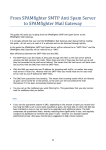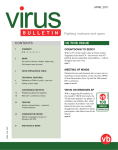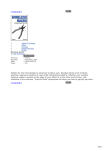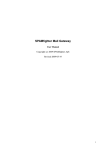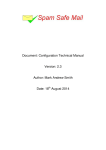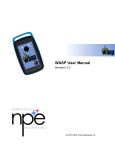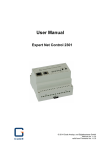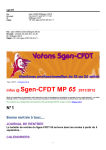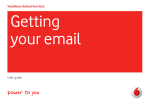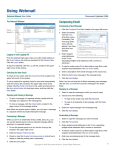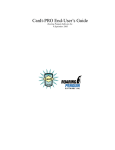Download SPAMfighter SMTP Anti Spam Server
Transcript
SPAMfighter SMTP Anti Spam Server Users Manual Copyright © SPAMfighter ApS 2005 Revised 4/27/2006 SPAMfighter ApS 1 Table of Contents 2 3 4 5 6 7 8 Terminology................................................................................................. 3 Technology .................................................................................................. 4 3.1 Tunneling and Interception ...................................................................... 4 3.2 Content Classification ............................................................................. 5 3.2.1 Spam Classification ............................................................................. 5 3.2.2 Virus Classification ............................................................................. 5 3.2.3 Language Classification (Q1 2006) ........................................................... 5 3.3 Policies and Actions ............................................................................... 6 3.4 Standards Conformance........................................................................... 6 Installation .................................................................................................. 7 4.1 Requirements ....................................................................................... 7 4.1.1 Environment ..................................................................................... 7 4.1.2 Operating System ............................................................................... 7 4.1.3 Hardware ......................................................................................... 7 4.1.4 Network and Firewall .......................................................................... 7 4.2 Deployment Checklist ............................................................................. 8 4.2.1 Installation ....................................................................................... 8 4.2.2 Configuration .................................................................................... 8 4.2.3 Testing ............................................................................................ 8 4.2.4 Deployment ...................................................................................... 8 4.3 Contents ............................................................................................. 9 Configuration ............................................................................................. 10 5.1 Tunnels............................................................................................. 10 5.1.1 Local Endpoint ................................................................................ 10 5.1.2 Remote Endpoint ............................................................................. 11 5.1.3 Testing .......................................................................................... 11 5.2 Domains and Mailboxes ......................................................................... 12 5.3 Policies............................................................................................. 13 5.4 Actions ............................................................................................. 14 5.4.1 Reject........................................................................................... 14 5.4.2 Redirect ........................................................................................ 14 5.4.3 Header Insertion .............................................................................. 15 5.4.4 Subject Prefixing.............................................................................. 15 5.4.5 Dump Message ................................................................................. 15 5.5 Sender Lists ....................................................................................... 16 5.6 LDAP Recipient Address Validation ........................................................... 17 Security Considerations ................................................................................. 18 6.1 Relaying............................................................................................ 18 6.2 Application Level Security...................................................................... 18 Monitoring and Statistics ............................................................................... 19 7.1 Performance Monitor ............................................................................ 19 7.2 Log Files ........................................................................................... 19 7.3 Statistics ........................................................................................... 19 Tunneling Details by Example ......................................................................... 20 8.1.1 Initiation........................................................................................ 20 8.1.2 Policy Selection ............................................................................... 20 8.1.3 Data Interception ............................................................................. 21 8.1.4 Policy Enforcement........................................................................... 21 8.1.5 Termination.................................................................................... 21 SPAMfighter SMTP Anti Spam Server Page 2 of 21 SPAMfighter ApS 2 Terminology For brevity, the “SPAMfighter SMTP Anti Spam Server” is often referred to as “the Filter” throughout this document. In addition, “Filter server” refers to the physical server on which the Filter is installed. SPAMfighter SMTP Anti Spam Server Page 3 of 21 SPAMfighter ApS 3 Technology 3.1 Tunneling and Interception In contrast to existing anti virus and anti spam mail solutions available today, the SMTP Anti Spam Server is not based on store-and-forward technology. This store-and-forward technology is often referred to as relaying and found in most mail gateway products. The SMTP Anti Spam Server offers a unique alternative acting as a network proxy inspecting SMTP traffic on-the-fly. This provides a number of significant advantages over existing solutions: 1. No local mail queues: • High performance since there is no need for disk activity • Low latency and no delivery delays • Reliable - no maintenance and backup needed for queues 2. Recipient address validation is still performed by your existing mail server: • No time wasted on setting up and maintaining active mailboxes, etc. • No excessive generation of non-delivery reports as seen on most store-and-forward solutions The high performance characteristics of this technology make it suitable for deployment in large enterprises, hosting centers and Internet Service Providers. Since there is no local mail queue, the Filter provides no additional protection against failure of the mail server. In that case, the usual rules apply: It is the responsibility of the delivering mail server to queue the mail and retry later. In this fashion no mails are lost but only delayed. Since the Filter works by inspecting the SMTP traffic before it reaches your mail server, it must be inserted between your internet connection (firewall) and mail server. This is accomplished by setting up a tunnel on your Filter server. A tunnel consists of a local endpoint (the local IP address and port on the server) and a remote endpoint (the IP address and port for SMTP traffic on the mail server). Once a connection is accepted on the local endpoint the Filter will immediately connect to the mail server and start inspecting/forwarding the traffic. To start accepting connections from the internet, you need to: 1. Set up a forwarding rule in your firewall, sending inbound SMTP connections to the local endpoint 2. Modify the MX record for your domain, point them toward the local endpoint (requires that the local endpoint is an IP address reachable from the internet) Any number of tunnels can be configured on a single Filter installation, thus a single Filter instance can protect multiple destination servers. Even though tunneling provides a number of advantages, it may be necessary to address certain security issues before deploying the Filter. Please read chapter 6 “Security Considerations” to fully understand the implications of tunneling. SPAMfighter SMTP Anti Spam Server Page 4 of 21 SPAMfighter ApS 3.2 Content Classification The SMTP Anti Spam Server provides a number of different classification mechanisms. Based on the classification of any given email, a number of actions may be performed. 3.2.1 Spam Classification SPAMfighter ApS employs a collaborative filtering technology in all of its products. The content classification is based on the generation of email signatures which is in turn used in an online voting system. Based on the votes of the more than 1.200.000 users of the SPAMfighter client software, the database is continuously updated. For each email the SMTP Anti Spam Server intercepts, it will generate the email signatures and query the voting servers. 3.2.2 Virus Classification The SMTP Anti Spam Server provides integration with the VIRUSfighter product suite. The virus scanner processes all email parts, compressed archives and nested emails. The VIRUSfighter scanning engine must be installed on the Filter server – however, it is not necessary to utilize the on-access file system scanner. A free 30 day trial of the VIRUSfighter product is available from: http://www.virusfighter.com. 3.2.3 Language Classification The SMTP Anti Spam Server features language classification. A weighted analysis is performed on all plaintext and HTML parts in the message (excluding attachments). The following languages are recognized: • • • • • • • • • • • • • • • • • Arabic Chinese Danish Dutch English Finnish French German Hebrew Italian Japanese Korean Norwegian Russian Spanish Swedish Thai SPAMfighter SMTP Anti Spam Server Page 5 of 21 SPAMfighter ApS 3.3 Policies and Actions A filtering policy can be defined for each recipient domain and mailbox which determines what action should be taken when an email is classified as spam. Based on the policy one or more of the following actions can be performed: • • • • • Reject the email before it reaches the destination server Redirect the email to any number of mailboxes Insertion of an email header line for later processing Prefixing of the subject header line for later processing Store a copy of (dump) the message to the local file system Policies also contain information about white- and blacklists and the threshold (sensitivity level) for spam detection. It is also possible to create policies which always performs (forces) an action, thus making it possible to create permanent redirects or rejections at the Filter level. 3.4 Standards Conformance The Filter conforms to these Internet standards: Document RFC 2821 RFC 2822 RFC 2045 RFC 2046 RFC 2047 Title Simple Mail Transfer Protocol Internet Message Format MIME: Multipurpose Internet Mail Extensions MIME: Media Types MIME: Message Header Extensions for Non-ASCII Text In addition, the following SMTP Service Extensions are supported: Document RFC 1652 RFC 1870 RFC 1891 RFC 2043 RFC 2554 RFC 2852 RFC 2920 Title SMTP Service SMTP Service SMTP Service SMTP Service SMTP Service SMTP Service SMTP Service Extension: 8 Bit MIME transport Extension: Message Size Declaration Extension: Delivery Status Notification Extension: Enhanced Status Codes Extension: Authentication Extension: Deliver By Extension: Command Pipelining Unsupported SMTP Service Extensions are suppressed by the Filter. SPAMfighter SMTP Anti Spam Server Page 6 of 21 SPAMfighter ApS 4 Installation 4.1 Requirements 4.1.1 Environment The Filter is targeted for installation on the Microsoft Windows platform. Due to the interoperability inherent in the SMTP protocol the product can be deployed effortlessly in a mixed environment. 4.1.2 Operating System Deployment on Microsoft Windows 2003 Server is recommended in performance-critical environments since the Filter will utilize a highly asynchronous communication model introduced in Microsoft Windows 2003 Server. The software is compatible with Microsoft Windows 2000 SP3 and later. The Microsoft .NET 2.0 Framework is required for the Configuration Tool and for exposure of Performance Monitor Data. The installation process will determine if the .NET Framework is missing and will install it accordingly. 4.1.3 Hardware The full Intel Pentium family of processors (and compatible) is supported. The Filter application is optimized for Pentium 4 and in addition scales linearly in multiprocessor systems. The memory footprint of the application is approximately 10 megabytes. As the Filter application buffers emails in memory, the actual consumption varies with the number of concurrent SMTP transactions and the size of each message. A good estimate for peak memory consumption in a medium-volume environment is 64 megabytes. The installation occupies approximately 5 megabytes of disk space (not including any dependencies such as the .NET Framework). A reasonable amount of disk space should be allocated for traffic log files, in most cases a few gigabytes suffice. Please review the “Log Files” chapter below. 4.1.4 Network and Firewall The Filter application will communicate with the SPAMfighter classification servers to assist in content classification. Periodical usage statistics are also reported back to the SPAMfighter licensing servers. The table below lists the firewall changes that are necessary: Protocol TCP UDP Source Address Server Address Server Address Port Dynamic Dynamic Destination Address smtp.licensing.spamfighter.com servers.backend.spamfighter.com Port 80 2409 Direction Out In / Out When using a stateful firewall with outbound traffic enabled it is not necessary to perform any changes. SPAMfighter SMTP Anti Spam Server Page 7 of 21 SPAMfighter ApS 4.2 Deployment Checklist To successfully deploy the SPAMfighter SMTP Anti Spam Server you need to complete the steps outlined below. Details related to the configuration steps are dealt with in later chapters. 4.2.1 Installation • • • Review the “Installation - Requirements” chapter Assign an appropriate server Modify the firewall configuration as outlined Review the “Security Considerations – Relaying” chapter Modify the existing mail server setup as outlined Download and launch the installation package: http://download.spamfighter.com/download/smtp/setup.exe 4.2.2 Configuration • • • Create tunnels between the Filter and existing mail servers Create or customize the filtering policies Create a list of domains to protect and select an appropriate policy for each 4.2.3 Testing • • • Start the Filter application in console mode Verify that the Filter is configured properly by sending a mix of legitimate and spam mails to the configured domains through the Filter Stop the Filter application 4.2.4 Deployment • • Start the Filter application in service mode Point the DNS MX records of the domains to the Filter server (or modify the firewall/network appliance configuration to direct traffic through the Filter) SPAMfighter SMTP Anti Spam Server Page 8 of 21 SPAMfighter ApS 4.3 Contents The installation process will create the user-defined installation directory and install the following files: File Filter.exe Configure.exe Description Filter application installed as a Windows Service Configuration Tool The Filter application is installed as a service named “SPAMfighter SMTP Anti Spam Server”. You can control the service behavior through the Service Control Manager. In addition a shortcut folder named Start → Programs → SPAMfighter SMTP Anti Spam Server is created containing these shortcuts: Shortcut Configure Documents → Manual Service → Start Service → Stop Service → Run in Console Description Starts the Configuration Tool User Manual Shorthand to start the Filter application as a service Shorthand to stop Filter application if running as a service Start the Filter application in console mode Please note that you must stop the service (if running), before starting the application in console mode. Two instances of the application can not run concurrently as the last to start will be unable to bind to the local endpoint(s). When the Filter application is running in console mode it can be stopped by pressing Ctrl-C. All configuration data is stored in the Windows Registry, but should only be modified through the Configuration Tool: HKEY_LOCAL_MACHINE\Software\SPAMfighter Filter Server. SPAMfighter SMTP Anti Spam Server Page 9 of 21 SPAMfighter ApS 5 Configuration The Configuration Tool is accessible through the SPAMfighter SMTP Anti Spam Server → Configure shortcut. It contains a tab for each of the chapters below. All configuration data can be modified on-the-fly, without restarting the Filter application. If a tunnel is modified or removed, the Filter application will wait until all active tunnel sessions have terminated before applying the changes. The screenshots included in this document illustrates an installation at a hosting center. 5.1 Tunnels Since the Filter acts as a proxy it needs information about the destination servers which it is protecting. A tunnel consists of two endpoints, the local and remote endpoint: 5.1.1 Local Endpoint The local endpoint consists of the address and port on which the Filter accepts connections for the tunnel. The default address is “0.0.0.0” which means that the Tunnel will accept connections on any address on the server. In scenarios where a single Filter installation is protecting multiple destination servers, it is necessary to assign multiple IP addresses to the Filter server: only a single tunnel can listen on any given address/port pair on a server. If it is unfeasible to assign multiple address, nonstandard port numbers can be used as discussed below. SPAMfighter SMTP Anti Spam Server Page 10 of 21 SPAMfighter ApS The assigned (standard) port number for the SMTP protocol is 25. If the tunnel is accepting connections directly from the Internet, it needs to listen on this port. It is possible to use a non-standard port number if a firewall capable of port translation is deployed on the network, or the Filter is behind some other kind of network appliance which can be configured to use the non-standard port number. Using a non-standard port is only recommended if: 1. Another application or tunnel is already listening on the address/port pair and 2. It is not feasible to assign more IP addresses to the server. 5.1.2 Remote Endpoint Once a connection is accepted on the local endpoint, the remote endpoint information is used to establish the tunnel. The address or hostname must be specified. The default port number is 25 but can be modified as necessary. 5.1.3 Testing Once a tunnel has been configured and enabled, the Filter application will start listening on the specified address and port. To verify that the tunnel is working properly, click Start → Run and type: telnet <local-address> <local-port> If the tunnel is working properly you should receive the same SMTP greeting as when executing: telnet <remote-address> <remote-port> If you do not receive a greeting when executing either of the commands, make sure that the SMTP service is running on the destination server. If you receive a greeting when connecting to the remote endpoint, but not the local endpoint make sure that the Filter application is running. If the Filter application is running but you are still unable to get the greeting, check the Server.log.txt log file in the installation directory for errors. SPAMfighter SMTP Anti Spam Server Page 11 of 21 SPAMfighter ApS 5.2 Domains and Mailboxes A filtering policy is defined per domain (or mailbox where required). See the following chapter for information about policies. Once a policy has been defined for a domain, all mailboxes associated with the domain will automatically inherit it. Exceptions to this inheritance are defined in the Mailboxes list. The “postmaster” mailbox should always be assigned a policy which delivers all emails. The “*“ wildcard can be used to define a policy for all other domains than those explicitly specified. Only a single policy can be active in a SMTP transaction. It is therefore important to limit the number of different policies used across a domain. Please refer to the “Tunneling Details by Example – Policy Selection” chapter for more details on this. SPAMfighter SMTP Anti Spam Server Page 12 of 21 SPAMfighter ApS 5.3 Policies A policy contains information about what action to execute when certain criterias are met: A policy can be configured to always execute the action. This is useful in creating permanent redirects or rejections for certain mailboxes at the filtering level. Black- and whitelists are also part of the policy: both are made up of sender lists. In this way a number of well-defined lists can be maintained easily and used in different policies. SPAMfighter SMTP Anti Spam Server Page 13 of 21 SPAMfighter ApS 5.4 Actions The Filter can be configured to perform a number of actions when triggered by a policy. Policies determine when a given action is executed as described in the previous chapter. A single action can perform multiple operations, i.e. modify the email header and redirect the message. 5.4.1 Reject Once the action is executed, the Reject operation will issue a SMTP error response to the “DATA” command: 554 Transaction Failed; Rejected by Content Filter Since this will terminate the SMTP transaction, the email will never be forwarded to the destination server. For further details please refer to the “Tunneling Details by Example” chapter below. Due to the nature of the reject operation, other operations can never be performed in the same action. 5.4.2 Redirect The redirect operation is capable of redirecting an email to multiple recipients on multiple domains. Since the redirected message is still delivered directly to the destination server, it must assume responsibility for the delivery and accept emails for the specified domains and mailboxes. SPAMfighter SMTP Anti Spam Server Page 14 of 21 SPAMfighter ApS The redirect operation uses a simple yet powerful rewriting engine. The user specifies a set of rewrite patterns, which are processed for each for the original recipients. The engine supports two variables which are replaced at execution time: Variable Name %domain% %mailbox% Description The domain part of the recipient email address The mailbox part of the recipient email address If the redirect operation is configured with these rewrite patterns: spam@%domain% spam.%mailbox%@%domain% [email protected] And the redirect operation is executed on a SMTP transaction with these recipients: [email protected] [email protected] Then the redirect operation will rewrite the recipients to: [email protected] [email protected] [email protected] [email protected] [email protected] The rewrite engine will remove any duplicate addresses generated by the operation. For backwards compatibility the rewrite pattern “address” is translated to “address@%domain%”. 5.4.3 Header Insertion The specified header field is added to the email header. The variable %reason% will be replaced with a description of why the action was executed. For instance: %reason% Spam: <probability>% Infected: <virus> Whitelisted Blacklisted Neutral Description Message was classified as spam Message contained an infected attachment or part Sender was whitelisted Sender was blacklisted Message was clean 5.4.4 Subject Prefixing When the action is executed the subject prefix operation simply adds the specified text to the beginning of the subject header. If no subject header exists one is created. 5.4.5 Dump Message The message will be written to the local file system using a unique file name. The file name will be logged in the tunnel log file. In the “Dump to:“ field you should enter the directory which you wish to store the dumps in. SPAMfighter SMTP Anti Spam Server Page 15 of 21 SPAMfighter ApS 5.5 Sender Lists Each sender list is a user-defined grouping of senders. Good examples of such groupings could be “Newsletters”, “Greeting Cards”, “Business Partners” etc. A list can contain both domain names as well as email addresses: The lists are combined in a policy to form black- and whitelists. SPAMfighter SMTP Anti Spam Server Page 16 of 21 SPAMfighter ApS 5.6 LDAP Recipient Address Validation Some destination servers (such as Exchange 5.5, 2000) and antivirus gateways are unable to perform recipient address validation during SMTP transactions. They simply accept the message and generate a Non-Delivery Report (NDR) if they determine that the recipient address is invalid or unknown. The lack of timely recipient address validation causes wasted server resources and skewed statistics. Fortunately, an LDAP profile can be associated with a tunnel to provide this validation. The search base is typically the distinguished name (DN) form of the domain name. The search filter supports these parameters: Variable Name %address% %domain% %mailbox% Description The full recipient email address The domain part of the recipient email address The mailbox part of the recipient email address SPAMfighter SMTP Anti Spam Server Page 17 of 21 SPAMfighter ApS 6 Security Considerations 6.1 Relaying Special attention should be paid while deploying the Filter. Due to the tunneling, all traffic originating from the Internet will appear to come from inside the internal network (from the perspective of the destination server). More specifically it will appear to originate from the Filter server. As such you should make sure that your destination servers do not allow relaying from the Filter server. Failing to do so will enable relaying for any Internet traffic (thus creating an Open Relay). 6.2 Application Level Security For increased security the Filter application can be configured to impersonate a user account with restricted privileges. The installation process will configure the Filter application to impersonate the “LocalSystem” account. Follow these steps to use an alternative account: 1. Create a new user account (e.g. “SMTP Anti Spam Server”) 2. Remove any group memberships for the account 3. Give the user account full control over these locations (including siblings): a. Registry: HKEY_LOCAL_MACHINE\Software\SPAMfighter b. Registry: HKEY_LOCAL_MACHINE\Software\SPAMfighter Filter Server c. File System: The Installation Directory chosen during Installation 4. Locate the “SPAMfighter SMTP Anti Spam Server” service in the Service Control Manager. Go to the “Log On” tab and select the newly created user account. SPAMfighter SMTP Anti Spam Server Page 18 of 21 SPAMfighter ApS 7 Monitoring and Statistics 7.1 Performance Monitor The Filter application exposes Performance Monitor Data in an object named “SPAMfighter SMTP Anti Spam Server”. A number of real-time counters are available. 7.2 Log Files Once the Filter application is run for the first time (either in console mode or as a service) a server log file named “Server.log.txt” is created in the installation directory. In addition a subdirectory named “Logs” is created. This directory will contain traffic logs for each tunnel, each named “tunnel-name.log.txt”. This is referred to as the “live” log for a tunnel. Live log files are locked when the Filter application is running but allows read-only access. Once a live log file exceeds 128 megabytes in size it will be archived as “tunnelname.timestamp.log.txt”, and a fresh live log file will be created. The archive log file lock is released by the Filter application thus allowing the file to be moved to alternate storage (for backup purposes etc.). 7.3 Statistics All domain and mailbox statistics are stored in the registry and reported back to a central licensing system. All statistics are available through a web interface. You’ll receive an email containing a link to the system once the installation has completed. It is possible to give external users access to the statistics (or parts of the statistics). Thus, in a hosting center setup, customers can get access to their own statistics. SPAMfighter SMTP Anti Spam Server Page 19 of 21 SPAMfighter ApS 8 Tunneling Details by Example In the example below the Filter accepts mail for domains “bar.com” and “n42.net”. The Filter is configured with different policies for the two domains. Notice the distinction between the “filtering policy” (enforced by the Filter) and the “delivery policy” (enforced by the destination server). 8.1.1 Initiation The session is initiated once the client (originating server) connects to the Filter. The Filter will then establish a tunnel between the client and the destination server by connecting to the server and acting as a proxy: Client → Client Client Client ← → ← Direction Filter Filter → Filter ← Filter → Filter ← Data Server Server Server Server Description Client connects to Filter Filter establishes Tunnel 220 bar.com Ready EHLO foo.com 250-bar.com Hello 250-8BITMIME 250-PIPELINING 250 HELP 8.1.2 Policy Selection The Filter will determine the filtering policy of a transaction by using the recipient addresses. These addresses are validated by the server before the filtering policy is locked: Client Client Client Client Direction Filter → Filter ← Filter Filter → ← Filter ← → ← → Server Server Server Server Data MAIL FROM: <[email protected]> 250 OK RCPT TO: <[email protected]> RCPT TO: <[email protected]> 250 OK Description Filter locks sender Filter resolves filtering policy Server checks delivery policy Filter locks filtering policy Only a single filtering policy can be active for any given transaction. The Filter will detect a policy conflict and respond with a temporary error, causing the client to retry later: Client Client → ← Direction Filter Filter Data RCPT TO: <[email protected]> 451 Policy Conflict Description Filter resolves filtering policy Filter detects a policy conflict The server is still responsible for performing recipient address validation. Hence the Filter does not need to know about each mailbox attached to a domain: Client Client Direction Filter Filter → ← Filter ← → Server Server Data RCPT TO: <[email protected]> RCPT TO: <[email protected]> 550 Unknown User SPAMfighter SMTP Anti Spam Server Description Filter resolves filtering policy Server checks delivery policy Server detects a delivery conflict Page 20 of 21 SPAMfighter ApS 8.1.3 Data Interception The Filter will buffer the message data to delay its delivery to the server. The message data will only be delivered to the server if the transaction passes the filtering policy: Client Client Client → ← → Direction Filter Filter Filter Data DATA 354 Go Ahead <Message Data> Description Filter buffers the message data During interception the Filter will issue periodic “NOOP” commands to the server to keep the session from timing out. 8.1.4 Policy Enforcement If the transaction is accepted it is forwarded to the Server: Client Direction Filter → Filter ← Filter → ← Filter ← Server Server Server Server Data DATA 354 Go Ahead <Message Data> 250 Message Saved Description Server accepted message data If the transaction is rejected by the filtering policy a policy action will be enforced. One such action might be to modify the message header and still forward it to the server. An action might also be configured to reject the message: Client Direction ← Filter Data 554 Content Rejected Description Or redirect the message to a predefined mailbox, in this instance <[email protected]>: Client Direction Filter → Filter ← Filter → Filter ← Filter → Filter ← Filter → Filter ← Filter → ← Filter ← Server Server Server Server Server Server Server Server Server Server Data RSET 250 OK MAIL FROM: <[email protected]> 250 OK RCPT TO: <[email protected]> 250 OK DATA 354 Go Ahead <Message Data> 250 Message Saved Server Server QUIT 220 Bye Description Reset transaction Server checks delivery policy Server accepted message data 8.1.5 Termination Client Client → ← Direction Filter → Filter ← Data SPAMfighter SMTP Anti Spam Server Description Page 21 of 21





















